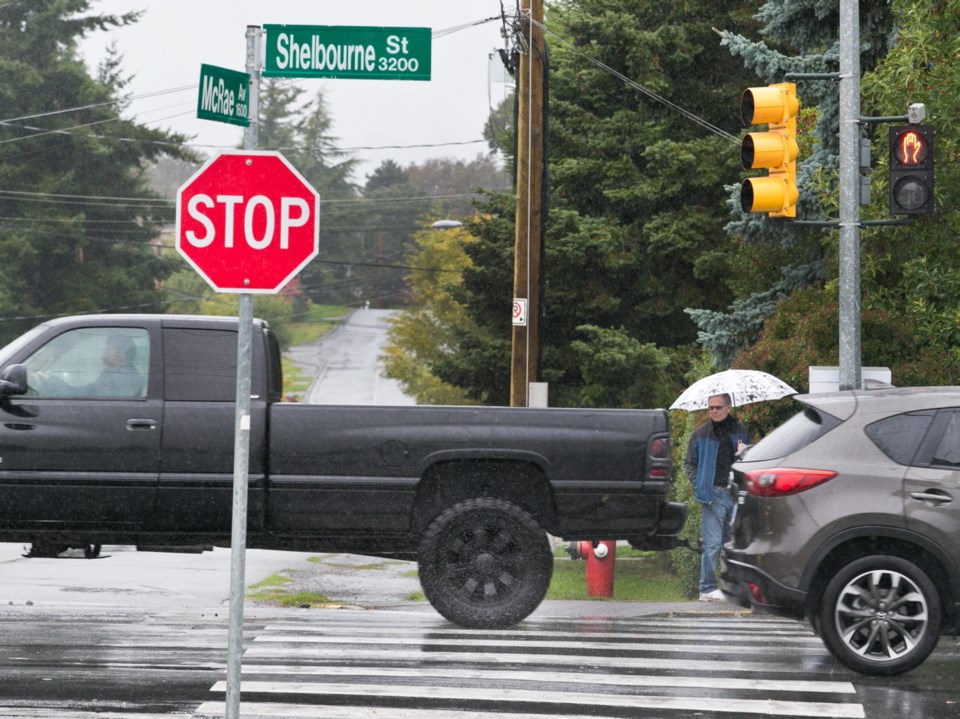Changes that embrace pedestrians and bicyclists as part of a more attractive streetscape are being pitched for a car-dominated, four-kilometre section of Shelbourne Street in Saanich — and council wants citizen advice on how to do it.
Bicycle lanes for Shelbourne were first identified as a priority in 1990 and it has been “a disappointing 25 years” waiting for change, said Daryl Wick, a veteran of the Saanich bicycle and pedestrian mobility advisory committee.
Cyclists and pedestrians face an average of 25,000 vehicles a day between North Dairy and McKenzie. The Shelbourne corridor has not been treated as a vital community with a busy road, but as a thoroughfare, council has been told.
Tom Newton of Shorncliffe Road, a member of the advocacy group Walk On Victoria, said it’s “scary” to walk along Shelbourne from North Dairy Road to Pear Street. “If a truck goes by, you really feel like you’re taking your life in your hands.”
He called it “disgraceful” that Saanich has not taken action sooner.
“It’s something that should have been done a long time ago,” agreed Mayor Richard Atwell.
Changes to the Shelbourne corridor between Feltham and North Dairy roads will depend on public feedback to two options, Atwell said.
Option 1, the less ambitious shorter-term plan, retains four lanes for motor-vehicle traffic, but includes new sidewalks, a bicycle lane separated by a physical barrier for 25 per cent of the four-kilometre stretch and upgrades to bike connector routes. That option would involve removal of almost 300 trees.
Option 2, a 30-year plan, would widen the Shelbourne right-of-way by up to eight metres in places, but have a bike lane for all four kilometres. Motor-vehicle traffic lanes would be reduced to two, three or four lanes in different segments to provide cyclists a dedicated 15 per cent of the right-of-way. Bus trips would take a little longer in peak periods. If a traffic lane is removed on Shelbourne, some vehicular traffic could divert to Cedar Hill Road, Richmond Road and Gordon Head Road.
Both options would cost roughly $10 million.
Many community members pressed councillors to vote for the short-term option and go to a public hearing, but council opted to have the community assess both options.
The Shelbourne corridor currently has no right-of-way dedicated for cyclists, said Coun. Vic Derman, chairman of the advisory committee.
Two-thirds of the street is allocated to vehicles, the rest to sidewalks and landscaping.
Derman described the stretch of Shelbourne from McKenzie Avenue to North Dairy Road as “aggressive, harsh and rather ugly — the best of the pedestrian infrastructure is barely acceptable.”
While walking it, he spotted just four cyclists, not the huge number that would be expected on a flat and direct route. “But they don’t feel safe and they don’t feel comfortable — and for good reason.”
He suspects there is pent-up demand for a Shelbourne cycling commuter route similar to the Galloping Goose.
“We just have to serve it.”
Coun. Susan Brice, chairwoman of the Greater Victoria Transit Commission, cautioned that whatever option is selected must accommodate public transit.
“Now and in the future, this mode of transportation is critical to a livable and healthy community.”
The idea of cutting down hundreds of trees to allow bicycling is “horrifying,” said Martin Simmons of Christmas Avenue, stressing Shelbourne is the route people choose because it is a necessary conduit — flat and direct — not a desirable one.
“It is not a fun street,” he said, suggesting Saanich look into biking and walking routes parallel to Shelbourne; for example, pathways could be used to link dead-end streets.



